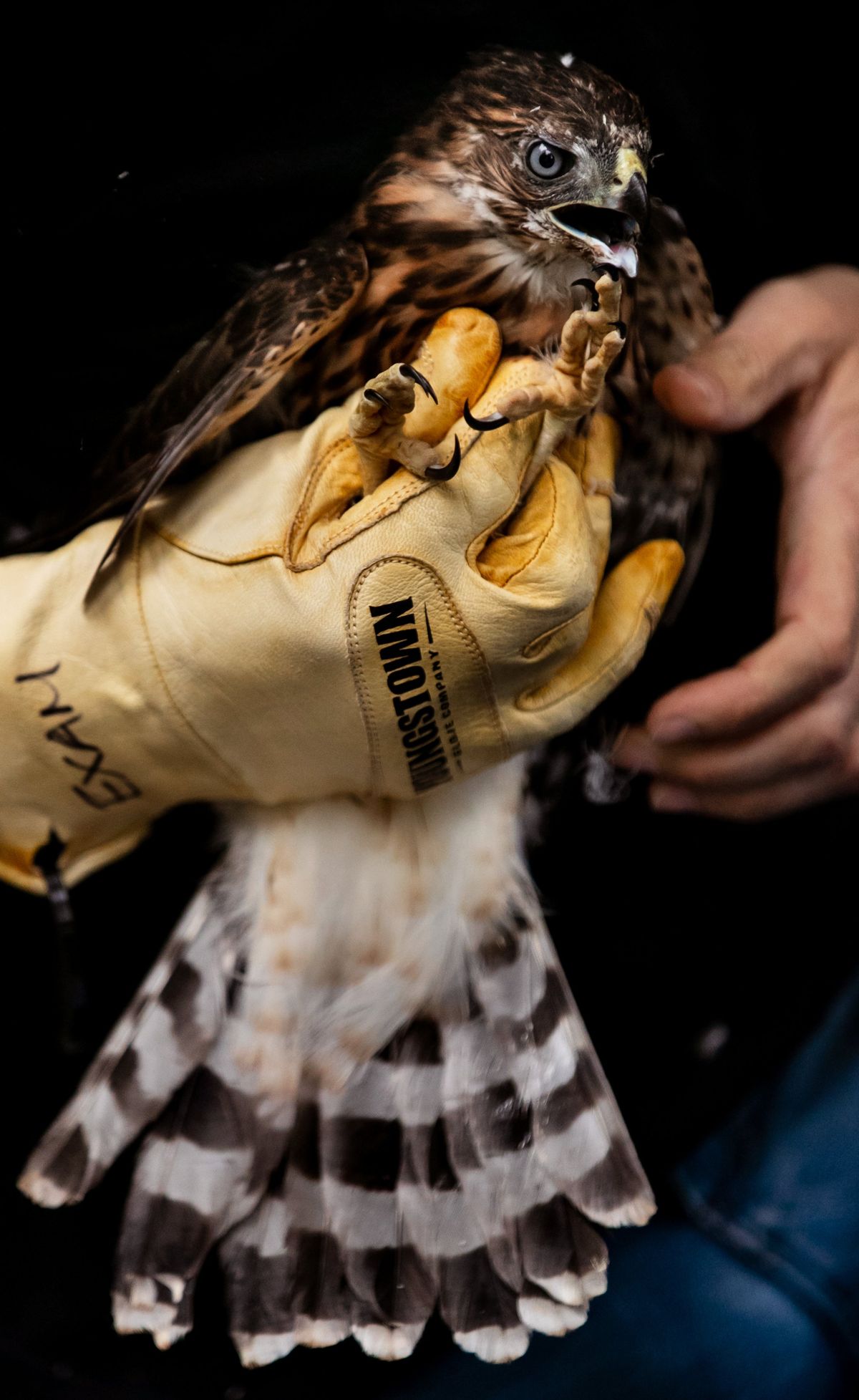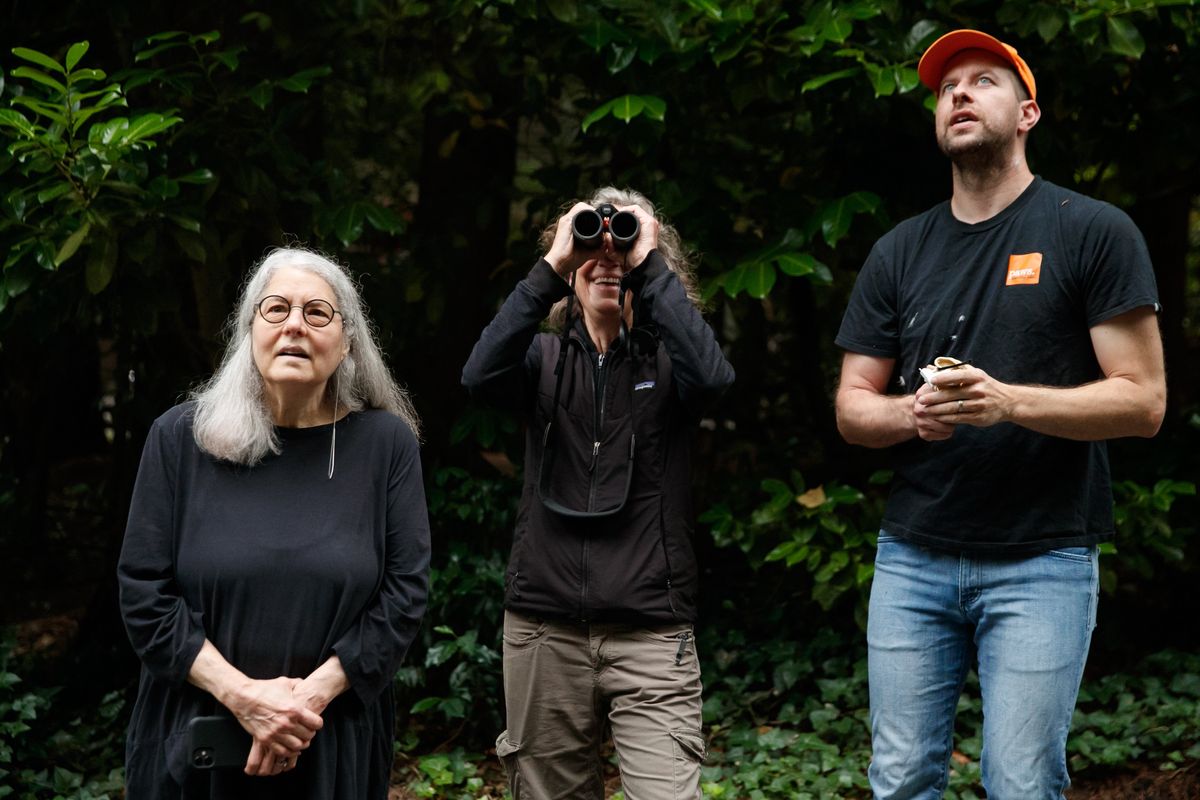Birds jumped from their nests to escape Seattle’s June heat wave. Some died. Others needed help.

Naturalist Jeff Brown bounded up a ladder, cradling a baby hawk into his torso as if it were a delicate football.
Brown, who helps rehabilitate wildlife for the PAWS Wildlife Center, stopped about 10 rungs up on this July morning, leaned his weight against a towering maple and slowly stretched out his hand.
The hawk’s talons curled around the fingers of Brown’s leather glove. It began to chitter with calls of alarm. Then, the baby bird beat its wings in a frenzy and darted tentatively across the shady street.
Just past a neighboring rooftop, the Cooper’s hawk, Patient #2021-2732, landed on a new perch to assess her surroundings – a place Brown hoped she would recognize as home.
Weeks ago and during a historic heat wave, the bird had apparently jumped from its nest in a towering cedar tree and fallen dozens of feet to the ground.
Bonnie Thompson Norman and a neighbor, who both live near the nest in Seattle’s Matthews Beach area, found the grounded bird – not much more than a puff ball that could hardly stand, much less fly – fed it some chicken, then gave it to PAWS for professional care.
“It was such a lightweight,” Norman said.
The bird was one of hundreds that came tumbling down during last month’s heat wave, which on June 28 sent Seattle temperatures soaring to 108 degrees.
Across the region, people found baby birds, including falcons, terns and eagles, dead or downed and suffering from heat.
“Everything is jumping out of the nest,” said Ed Deal, the president of Seattle’s Urban Raptor Conservancy. “They’re baking in the heat and they’re trying to get away from it.”
Local biologists said the birds’ behavior is the first in memory for the Pacific Northwest.
“I’ve never seen anything like it,” said Bud Anderson, a longtime raptor biologist.

Burned feet, broken wings
The heat wave, which is responsible for at least 125 people’s deaths in Washington state, sent Seattle temperatures above 100 for three days, buckling roads and overwhelming emergency rooms. Climate scientists say the event would have been virtually impossible if not for climate change.
Animal rehabilitation centers were flooded, too, with an influx of baby birds, including some with broken wings, others with dehydration or heat stress.
In the aftermath of the heat wave, the PAWS Wildlife Center in Lynnwood received 31 raptors, including eight bald eagles, three barn owls, 11 Cooper’s hawks, five merlins, three red-tailed hawks and a sharp-shinned hawk.
It took in 44 swallows, which are insect-eating songbirds, and also 53 Caspian terns, which are seabirds with distinctive orange bills, also, making the summer – usually a busy season – “nonstop,” said Dr. Nicki Rosenhagen, a PAWS veterinarian.
The terns – which live in large colonies – arrived from a group living on top of a vacant industrial building south of downtown Seattle. As the temperature peaked, dozens of baby birds jumped from the roof to escape the heat, Rosenhagen said. Dozens died.
Many that survived “had burns – foot lesions on the bottom of their feet,” Rosenhagen said. “A number had broken wings and broken legs.”
The raptors at PAWS – all juveniles – fared better. Most were suffering from dehydration or were in poor physical condition, but otherwise uninjured.
Deal, of the raptor conservancy, knows of at least three Cooper’s hawk nests where young birds died in Seattle during the heat wave, including three downy hawks found in a crumpled heap beneath a nest in southeast Seattle’s Cheasty Greenspace.
He suspects the heat wave affected at least two more failed nests in Seattle, which has more than 60 nests overall.
The heat wave’s impacts were widespread. The Portland Audubon Society said it had admitted more than 100 Cooper’s hawks to its wildlife care center. And the Sarvey Wildlife Center in Arlington cared for dozens of dehydrated or injured swallows.
“ Over 50 in a couple days. That was crazy to get in that many birds at one time,” said Jessica Paolello, Sarvey’s clinic manager, who had to stock up on supplies – ordering 150,000 extra mealworms – to ensure the birds remained well-fed during their stay.
Testing endurance
Extreme heat affects birds much as it does humans.
Birds’ normal body temperatures range from about 104 to 110 degrees, according to Blair Wolf, a professor of biology at the University of New Mexico.
When body temperatures climb too high, birds must evaporate water to cool down. They often do so by panting, though some can lose water across their skin.
When heat exceeds birds’ normal body temperatures, avian eggs can overheat and fail, said Steven Beissinger, an ornithologist and professor of ecology and conservation biology at the University of California, Berkeley.
Beissinger, who has studied birds in the Mojave Desert, said parents will often stand over nests to provide shade or fly great distances to wet their wings to cool eggs. Beissinger suspects birds here might not have developed such responses to heat.
“These behaviors might not be innate,” Beissinger said.
When extreme temperatures threaten adults, they can become dehydrated or stressed.
“They may leave their nest to eat or drink and may expose the young,” Wolf said. “When it’s really hot, the adults often suspend activity. They may not be motivated to feed the young.”
Young Cooper’s hawks like Patient #2021-2732 often move around in nests, even before they’re able to fly.
“They may well jump out in the heat if they get too much stress,” Wolf said.
Birds’ overall heat tolerance varies not only by species, but by region.
In experiments, Wolf has tested and measured birds’ physiological responses in a device called a metabolic chamber.
Wild birds spend about three hours at rest in these darkened chambers, as Wolf manipulates environmental conditions, like air temperature, and measures their responses. The birds are pushed to their limit, then released unharmed, helping Wolf examines species’ endurance limits in a warming climate.
The research suggests the same species of bird would fare better in heat if it lived in Silver City, New Mexico, rather than Seattle. Their bodies are better acclimated.
“The largest natural killer of humans is heat,” Wolf said. “Birds are more adapted to deal with heat, but not temperatures like this when they don’t see them normally.”
“Continuous stress”
Die-offs of birds during terrestrial heat waves are “highly unusual,” Wolf said.
Researchers have documented a few, including a pattern of deaths in South African swallows when high temperatures climbed above 109 degrees.
Climate scientists expect heat waves to increase in intensity and frequency.
With climate change, Wolf said damaging heat waves – such as those once expected every 50 to 100 years – could increase in frequency until they become almost routine.
Wolf expects “that continuous stress on animal populations” to hamper many species of birds.
But the impacts of climate change are uneven, Beissinger said, and the Pacific Northwest’s varying topographies and climates make it challenging to predict exactly how birds will adjust.
Some species could move, seeking a new “thermal niche.” Others are changing migration patterns or when they nest.
Wolf fears warming will outpace birds’ ability to adapt and evolve, particularly as direct threats like heat waves combine with other problems, such as habitat and resource shifts.
“It’s happening so rapidly,” Wolf said. “This is another stressor stacked on top on an already declining community.”
With a little luck
When Brown returned to the ground in the Matthews Beach neighborhood, his T-shirt was dotted in downy feathers, not an unusual site these days.
Work had become a “marathon” for Brown as PAWS scrambled to reunite heat-affected birds with their families or with fosters. The goal is return the birds to their families as soon as they are healthy and can fly.
He was hopeful for Patient #2021-2732, who hadn’t accepted his chosen branch, but remained close enough to the nest from which she’d apparently jumped three weeks ago. She’d made a racket – a good sign.
“They’re aware of her now,” Brown said of her siblings and parents.
Minutes later, Brown heard a cacophony of cries from the siblings. An adult hawk approached, presumably with prey.
“That’s dad,” said Deal, who had scouted the release site and found the nest. “This is what we wanted to hear – commotion.”
With a little luck – and a lot of human help – Patient #2021-2731 would follow those cries back to her family and survive the heat wave that rattled her nest, her ecosystem and much of the Pacific Northwest.